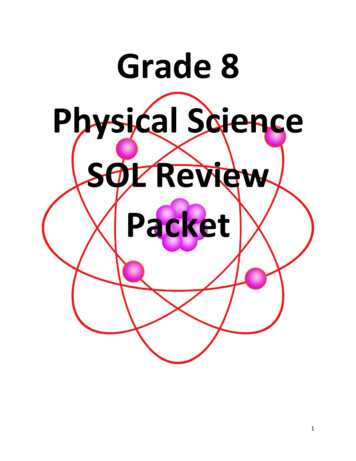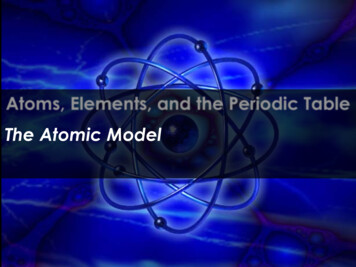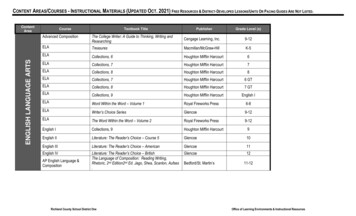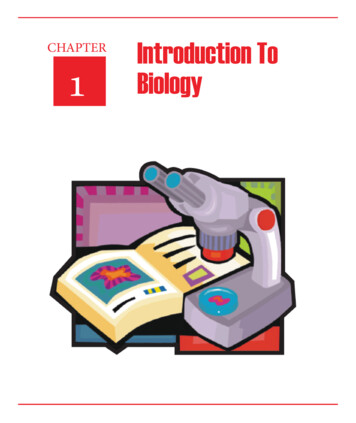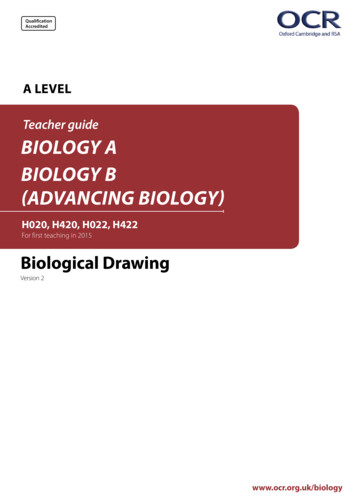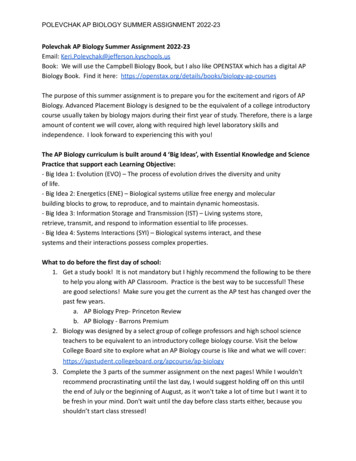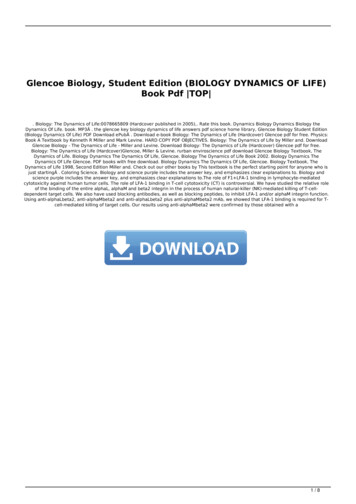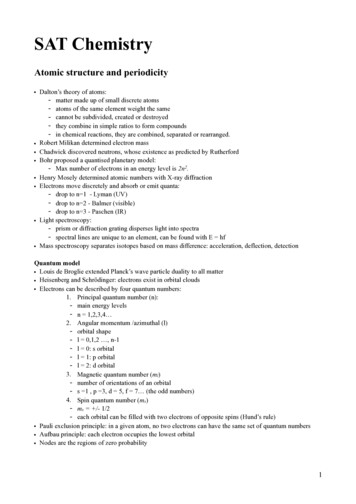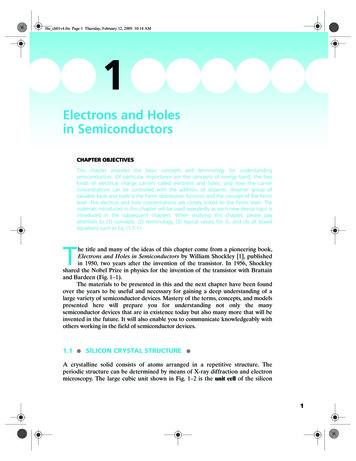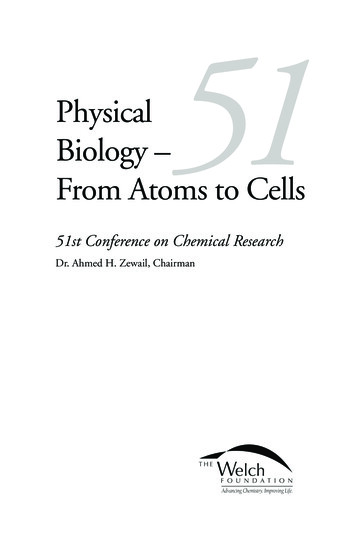
Transcription
51PhysicalBiology –From Atoms to Cells51st Conference on Chemical ResearchDr. Ahmed H. Zewail, Chairman
THE ROBERT A. WELCH FOUNDATION51ST CONFERENCE ON CHEMICAL RESEARCHPHYSICAL BIOLOGY – FROM ATOMS TO CELLSOctober 22-23, 2007The Welch Foundation is a legacy to the world from Robert AlonzoWelch, a self-made man with a strong sense of responsibility to humankind, an enthusiastic respect for chemistry and a deep love for hisadopted state of Texas. Mr. Welch came to Houston as a youth and latermade his fortune in oil and minerals. Over the course of his career andlife he became convinced of the importance of chemistry for the betterment of the world. He had a belief in science and the role it would playin the future. In his will, Mr. Welch stated: “I have long been impressedwith the great possibilities for the betterment of Mankind that lay in thefield of research in the domain of chemistry.” Mr. Welch left a generousportion of his estate to his employees and their families. The balancebegan what is now The Welch Foundation.The Welch Foundation, based in Houston, Texas, is one of theUnited States’ oldest and largest private funding sources for basicchemical research. Since its founding in 1954, the organization hascontributed to the advancement of chemistry through research grants,departmental programs, endowed chairs, visiting lectureships, and otherspecial projects at educational institutions in Texas. The Foundationpresents the Welch Award in Chemistry for chemical research contributions which have had a significant positive influence on mankind. TheFoundation also bestows the Norman Hackerman Award in ChemicalResearch, an award that recognizes the work of young researchers inTexas.Each year since 1957, The Robert A. Welch Foundation hosts aconference which draws leading scientists from around the world to explore state-of-the-art research in various areas of chemistry. The Foundation sponsors these annual conferences in order to support increasedfundamental research in chemistry.This year's two-day conference will be held on October 22-23,2007, at The Hilton Houston North Hotel in Houston. The title ofthe 51st annual Welch Conference in Chemical Research is: PhysicalBiology – From Atoms to Cells. Presiding over the conference will be amember of the Welch Scientific Advisory Board, Dr. Ahmed H. Zewail,Linus Pauling Chair Professor of Chemistry and Physics, CaliforniaInstitute of Technology .
2
Directors and OfficersJ. EVANS ATTWELLChairmanand DirectorERNEST H. COCKRELLTreasurer andDirectorDENNIS R. HENDRIXVice Chairman andDirectorWILHELMINA E. (BETH)ROBERTSONSecretary andDirectorPETER J. FLUORDirectorNORBERT DITTRICHPresident
SCIENTIFIC ADVISORY BOARD(Year Indicates Date of Joining SAB)JAMES L. KINSEY(Chairman); D. R. Bullard-Welch FoundationProfessor of Science, Rice University (2006)E. J. COREYProfessor of Chemistry, Harvard University. (1968)PETER B. DERVANProfessor of Chemistry, California Institute ofTechnology. (1988)MARYE ANNE FOXChancellor, University of California, San Diego. (1998)JOSEPH L. GOLDSTEINProfessor and Chairman of Molecular Genetics, TheUniversity of Texas Southwestern Medical Center atDallas. (1986)YUAN T. LEEPresident Emeritus and Distinguished Research Fellow,Academia Sinica, Taipei, Taiwan and University ProfessorEmeritus, University of California, Berkeley. (1988)WILLIAM N. LIPSCOMB, JR.Professor of Chemistry Emeritus, Harvard University.(1982)PETER G. SCHULTZProfessor, Scripps Research Institute and Director of theGenomics Institute of the Novartis ResearchFoundation. (2003)AHMED H. ZEWAILLinus Pauling Chair Professor of Chemistry andProfessor of Physics, California Institute of Technologyand Director of the National Science FoundationLaboratory for Molecular Sciences. (2002)
E. J. CoreyJames L. KinseyMarye Anne FoxPeter B. DervanJoseph L. GoldsteinYuan T. LeePeter G. SchultzWilliam N. Lipscomb, Jr.Ahmed H. Zewail
PROGRAMPHYSICAL BIOLOGY–FROM ATOMS TO CELLSMonday, October 22, 20078:308:35J. EVANS ATTWELL, Chairman of the Board of DirectorsAHMED H. ZEWAIL, California Institure of Technology, Conference ChairmanSESSION I – Visualization: From Atoms to Cells8:40ROGER D. KORNBERG, Stanford University, Discussion Leader8:509:25SIR JOHN M. THOMAS, University of Cambridge, "Revolutionary Developments fromAtomic to Extended Structural Imaging"Discussion9:3510:10SIR JOHN E. WALKER, University of Cambridge, "Rotary Motors with :10STEPHEN QUAKE, Stanford University, "Microfluidic Large Scale Integration"Discussion11:2011:55CARLOS J. BUSTAMANTE, University of California, Berkeley, "Biological SSION II – Theory and Computation for Complexity1:30J. ANDREW MCCAMMON, University of California, San Diego, Discussion Leader1:402:15PETER G. WOLYNES, University of California, San Diego, "Protein Folding and Beyond"Discussion2:253:00MICHELE PARRINELLO, Swiss Federal Institute of Technology, "Simulating Complexity:Challenges and Progress in Atomistic Simulations"Discussion3:103:45ROB PHILLIPS, California Institute of Technology, "The Physics of Genome Management"Discussion3:55Adjorn
Tuesday, October 23, 2007SESSION III – Macromolecular Function8:00DOUGLAS C. REES, California Institute of Technology, Discussion Leader8:108:45RODERICK MACKINNON, The Rockefeller University, "The Mysterious Cell Membrane"Discussion8:559:309:40CHRISTOPHER M. DOBSON, University of Cambridge, "Protein Misfolding andDisease"DiscussionBreak9:5510:30DAVID A. TIRRELL, California Institute of Technology, "Alternative Translations of RNAMessages"Discussion10:4011:15GEORGE M. WHITESIDES, Harvard University, "Why is it so Difficult to Design Ligandsthat Bind to Proteins"Discussion2007 Welch Awardee Lectures11:25NOEL S. HUSH, University of Sydney, "Symmetry Breaking, Delocalization and Dynamicsin Electron Transfer Systems"11:50WILLIAM H. MILLER, University of California, Berkeley, "Using the Initial ValueRepresentation of Semiclassical Theory to Add Quantum Effects to Classical MolecularDynamics Simulations"12:15LUNCHSESSION IV – From Cells to Consciousness1:15ALEXANDER VARSHAVSKY, California Institute of Technology, Discussion Leader1:252:00DAVID BALTIMORE, California Institute of Technology, "Inflammation: NF-kB andMicroRNAs Play Their Roles"Discussion2:102:452:553:303:40LEROY HOOD, Institute for Systems Biology, "Systems Biology Will Transform Medicine"DiscussionCHRISTOF KOCH, California Institute of Technology, "The Neurobiology ofConsciousness"DiscussionAdjorn
A hmed H. ZewailCalifornia Institute of Technology, Conference Chairman8:35 am - Monday, October 22, 2007Ahmed H. Zewail is presently theLinus Pauling Chair Professor ofChemistry and Professor of Physics.For ten years, he has been the Directorof the NSF Laboratory for Molecular Sciences (LMS) at the CaliforniaInstitute of Technology (Caltech).Currently, he is the Director of thePhysical Biology Center at Caltech.Dr. Zewail was awarded the 1999Nobel Prize for his development of thefield of femtochemistry, making possible discoveries of phenomena on thefemtosecond timescale. He received anumber of other awards, including theAlbert Einstein World Award (2006),Benjamin Franklin Medal (1998),Robert A. Welch Award (1997), Leonardo da Vinci Award (1995), WolfPrize (1993), and the King Faisal Prize(1989). From Egypt he received theOrder of the Grand Collar of the Nile,the highest state honor. Postage stampshave been issued to honor his contributions to science and humanity.Dr. Zewail holds honorary degreesin the sciences, arts, philosophy,law, and medicine from some thirtyuniversities around the world, and is amember of the National Academy ofSciences, the American PhilosophicalSociety, and the American Academyof Achievement. He is also an electedmember of the Pontifical Academy ofSciences, the European Academy ofArts, Sciences, and Humanities, theRoyal Society of London, the RussianAcademy of Sciences, and the RoyalSwedish Academy of Sciences. Dr. Zewail currently serves onseveral boards of international institutions of higher education. He has beena Chief Editor of Chemical PhysicsLetters (1991-2007) and currently isthe Honorary Advisory Editor. He wasalso a member of the Board of Directors of TIAA-CREF (2004-2007), andsince 2002 has been a member of theScientific Advisory Board of the WelchFoundation.At present, the focus of Dr.Zewail’s research group is mainly onthe understanding of complexity inchemical and biological transformations in the four dimensions of spaceand time.
Physical Biology–From Atoms to CellsMolecular biomachines are complex,not only in their structure but also because they operate in the non-equilibrium state. New frontiers of research arenow directed towards the observationof phenomena as they occur in spaceand time—visualization—and towardsconceptionalization of the meaningand control of complexity. Studies atthis level of the physics and chemistryof biology constitute the foundation ofphysical biology. As a new discipline,physical biology aims at understandingmechanistically how physical forcesand collective interactions governbiological function. From the molecular to cellular length scale and on thetime scale of motions, femtoseconds toseconds, such studies of structures andtheir behavior in motion provide thebasic understanding for decipheringcomplexity—how the pieces are made,how their physical forces exert control,and how feedback and feedforwardof elements allow for robustness andfunction.The 2007 Welch Conference onChemical Research, Physical Biology—from Atoms to Cells, is structured toprovide a broad perspective on currentstate-of-the-art methods and conceptscentral to chemical and biologicalbehavior. The two-day conferencehas four sessions broadly covering thefollowing topics: Visualization, Theoryand Computation for Complexity,Macromolecular Function, and FromCells to Consciousness. The conferencebrings together 18 of the world’s mostoutstanding scientists in the areas covered. These areas include microscopy,crystallography, microfluidics, singlemolecule spectroscopy, protein foldingand misfolding, abiological assemblies,molecular and systems biology, andconsciousness and quantum mechanicsof the brain.The opening session, led by RogerKornberg, addresses current methodsof visualization in four talks by SirJohn Thomas, Sir John Walker, Stephen Quake, and Carlos Bustamante.The afternoon session, led by AndrewMcCammon, is devoted to theory andcomputation, from macromolecules tocellular structures, with talks by PeterWolynes, Michele Parrinello, and RobPhillips. The opening session on thesecond day is led by Doug Rees and isdevoted to macromolecular functionwith talks by Rod MacKinnon, ChrisDobson, David Tirrell, and GeorgeWhitesides. The closing session, ledby Alex Varshavsky, covers areas of research from cells to consciousness, withtalks by David Baltimore, Leroy Hood,and Christof Koch.Included in the above program isa special lectures by the 2007 WelchAwardees.
10
Roger D. KornbergStanford University, Discussion Leader8:40 am - Monday, October 22, 2007Roger Kornberg is Winzer Professor in Medicine in the Departmentof Structural Biology at StanfordUniversity. In his doctoral research,he demonstrated the diffusional motions of lipids in membranes, termedflip-flop and lateral diffusion. He wasa postdoctoral fellow and member ofthe scientific staff at the Laboratory ofMolecular biology in Cambridge, England from 1972-5, where he discoveredthe nucleosome, the basic unit of DNAcoiling in chromosomes. He moved tohis present position in 1978, where hisresearch has focused on the mechanismand regulation of eukaryotic gene transcription. Notable findings include thedemonstration of the role of nucleosomes in transcriptional regulation, theestablishment of a yeast RNA polymerase II transcription system and theisolation of all the proteins involved,the discovery of the Mediator of transcriptional regulation, the developmentof two-dimensional protein crystallization and its application to transcription proteins, and the atomic structuredetermination of an RNA polymeraseII transcribing complex. Kornberg’sawards include the 2001 Welch Awardand the 2006 Nobel Prize in Chemistry(unshared). Kornberg’s closest collaborator has been his wife, Dr. YahliLorch. They have three children, Guy,Maya, and Gil.11
Sir John M. ThomasUniversity of Cambridge8:50 am - Monday, October 22, 2007John Meurig Thomas is Honorary Professor of Solid-State Chemistry at the Department of MaterialsScience, Cambridge. A graduate ofthe University of Wales (Swansea), hetaught and researched at Bangor andAberystwyth for 20 years before hebecame Head of Physical Chemistry atCambridge I3 in 1978, and Director of the Royal Institution of GreatBritain, London (1986-91). He laterreturned to pursue his research inCambridge, and was Master of Peterhouse from 1993-2002.A pioneer of solid-state chemistryand an expert on the design, synthesis and in situ characterization ofheterogeneous catalysts, his work onsingle-site solid catalysts has produceda strategy for the creation of new inorganic catalysts, many of which havebeen exploited commercially. He hasassembled numerous solid catalystsfor environmentally benign processes,such as the regio-, shape-, and enantio-selective conversions of organicmolecules in air or oxygen.His early work focused onchemical and electronic consequencesof imperfections in solids and thisprompted him to adapt various formsof electron microscopy for the retrieval of chemical information. Manynew families of structures have beendiscovered by him. In recognition ofhis investigations in geo-chemistry(involving the deployment of microscopy, NMR and synchrotron radiation) a new mineral, Meurigite,12was named in his honour.The recipient of many awards(Davy Medal, Faraday Medal, theWillard Gibbs and Linus PaulingMedals), he also has several honorarydoctorates in the UK, US, Australia,Europe, Africa and Japan. A foreignFellow of the American PhilosophicalSociety and of many national academies, he was chairman of CHEMRAWN (Chemical Research Appliedto World Needs) of IUPAC, 1988-92.In 1991 he was knighted by QueenElizabeth II “for services to chemistryand the popularization of science.”
Revolutionary Developments from Atomic toExtended Structural ImagingOf the three kinds of primary beams(neutrons, X-rays and electrons) suitable for structural imaging, the mostpowerful are coherent electrons. Thesource brightness of such electrons significantly exceeds achievable values forneutrons and X-rays: their minimumprobe diameter is as small as 0.1nm,and their elastic mean-free path is ca10nm (for carbon), much less thanfor neutrons and X-rays. Moreover,because electrons are focusable andmay be pulsed at sub-picosecond rates,and have appreciable inelastic cross-sections, electron microscopy (EM) yieldsinformation in four distinct ways: inreal space, in reciprocal space, in energyspace and in the time domain. Thus,besides structural imaging, energylandscapes of macromolecules may beexplored, and under optimal conditions elemental compositions, valencestates and 3D information (fromtomography) may be retrieved by timeresolved EM.Advances in designs of aberration-corrected high-resolution electronmicroscopes have greatly enhancedthe quality of structural informationpertaining to nanoparticle metals,binary semiconductors, ceramics andcomplex oxides. Moreover, electrontomography sheds light on the shape,size and composition of bimetalliccatalysts attached to nanoporous sup-ports. With energy-filtered electrontomography, chemical compositions ofsub-attogram quantities located at theinterior of microscopic objects may beretrieved non-destructively.Radiation damage is the mainproblem which prevents the determination of the structure of singlebiological macromolecules at atomicresolution using any kind of microscopy, irrespective of the primary beam.Great advances have recently beenmade via the EM of biological macromolecules and machines embedded invitreous ice. Electron cryomicroscopyis now used to analyze the structuresof molecules arranged as 2D crystals,helical arrays or as single particles;and cryoelectron tomography revealsnuclear pore complex structure anddynamics. Zewail’s revolutionarysingle-electron (4D) ultrafast-EMand diffraction is poised to contribute richly to the structural imagingof both atomic and macromolecularspecies.13
Sir John E. WalkerUniversity of Cambridge9:35 am - Monday, October 22, 2007JcalohnResearchWalker is Director of the MediCouncil Dunn HumanNutrition Unit in Cambridge, UK.In 1974 he joined the Laboratory ofMolecular Biology in Cambridge, UKwhere he helped to discover overlapping genes in bacteriophages and themodified genetic code of mitochondrialDNA. In 1978 he began studying theATP synthase complex from mitochondria and bacteria, resulting in acomplete sequence analysis from severalspecies. This was the overture to hiswork leading, in 1994, to the resolution of the 3D structure of the catalyticdomain and central rotary stalk by Xray crystallography. The crystal structure pointed at once towards a rotarymechanism of ATP synthesis mediatedby the asymmetry of the structureimposed by the rotating central “stalk”.Since this work, John has continued tounravel the secrets of this all-importantenzyme demonstrating an unforeseensubunit stoichiometry that has led tonew theories of the molecular mechanics of this nanomachine, and thestructure of the stator.In addition he has established thesubunit composition of complex I,another highly complex membranebound enzyme of the mitochondrionmade of 45 different proteins, and hehas defined transport pathways acrossinto mitochondria.In 1995 he was elected Fellowof the Royal Society. In 1997, he wasawarded the Nobel Prize in Chemistryjointly with Dr. Paul Boyer for14their elucidation of the enzymaticmechanism underlying the synthesisof adenosine triphosphate (ATP). Heis a Foreign Member of L’AccademiaNazionale dei Lincei, Rome, Italy andthe Royal Netherlands Academy ofSciences, and a Foreign Associate ofthe National Academy of Sciences,USA.
Rotary Motors at Atomic-Scale ResolutionThe lecture will describe the detailedworkings of two rotary machinesin biology. One, the ATP synthaseis essential for life. The other, thebacterial flagellar motor provides themeans for motile bacteria to find nutrients and to escape repellents. Theworkings of both machines have beenrevealed largely by a combination ofstructural biology and biophysics.They are both driven by energy froma transmembrane proton potentialgradient generated by oxidativemetabolism of foodstuffs. In the ATPsynthase the rotary motion is coupleddirectly to chemistry that convertsadenosine diphosphate to adenosinetriphosphate. The rotary action of theflagellar motor turns the flagellum,and depending on the direction ofrotation the bacteria either tumble orswim forwards. The components ofthe machines that generate rotationare likely to have a common evolutionary origin.15
Stephen QuakeStanford University10:35 am - Monday, October 22, 2007Stephen Quake studied physics (BS1991) and mathematics (MS 1991) atStanford University before earning hisdoctorate in physics from Oxford University (1994) as a Marshall scholar.He then spent two years as a post-docin Nobel Laureate Steven Chu's groupat Stanford developing techniques tomanipulate single DNA molecules withoptical tweezers. In 1996 Quake joinedthe faculty of the California Institute ofTechnology, where he rose through theranks and was ultimately appointed theThomas and Doris Everhart Professorof Applied Physics and Physics. Quakemoved back to Stanford in 2004 tohelp launch a new department in Bioengineering.Quake's interests lie at the nexusof physics, biology and biotechnology. Over the past half decade, he hasfocused on understanding the basicphysics and biological applications ofmicrofluidic technology. His grouppioneered the development of Microfluidic Large Scale Integration (LSI),demonstrating the first integratedmicrofluidic devices with thousands ofmechanical valves. This technology ishelping to pave the way for large scaleautomation of biology at the nanoliterscale, and he and his students havebeen exploring applications of "lab on achip" technology in functional genomics, genetic analysis, and protein design. Throughout his career, Quake hasalso been active in the field of singlemolecule biophysics; he has focused onprecision measurements16on single molecules, and in 2003 hisgroup demonstrated the first successful single molecule DNA sequencingexperiments.Quake received "Career" and"First" awards from the NationalScience Foundation and National Institutes of Health in 1997, was nameda Packard Fellow in 1999, was in theinaugural class of NIH Director'sPioneer Awards in 2004, and in 2005was selected as an investigator of theHoward Hughes Medical Institute.His contributions to the developmentof new biotechnology at the interfacebetween physics and biology have beenrecognized by recent awards from theMIT Technology Review Magazine,Forbes, and Popular Science. He is afounder and scientific advisory boardchair of Fluidigm, Inc and HelicosBiosciences, Inc.
Microfluidic Large Scale IntegrationThe integrated circuit revolutionchanged our lives by automatingcomputational tasks on a grand scale.My group has been asking whether asimilar revolution could be enabledby automating biological tasks. Tothat end, we have developed a methodof fabricating very small plumbingdevices – chips with small channelsand valves that manipulate fluidscontaining biological molecules andcells, instead of the more familiarchips with wires and transistors thatmanipulate electrons. We have beenusing these tools to investigate areasranging from single cell gene expression in stem cells to deconstructingcomplex microbial systems.17
Carlos J. BustamanteUniversity of California, Berkeley11:20 am - Monday, October 22, 2007Carlos J. Bustamante received aPh.D. in biophysics in 1981 from theUniversity of California, Berkeley.Since 1994, Dr. Bustamante has heldan appointment as a Howard HughesMedical Institute Investigator. In1998, he became the director for theAdvance Microscopies Department atLawrence Berkeley National Laboratory, and a Professor of Physics aswell as Molecular and Cell Biology atBerkeley. His research interests includesingle molecule manipulation methodsand their application to investigatevarious biochemical processes: torquemeasurements on single DNA molecules, reversible folding of single RNAmolecules by force, and the mechanochemistry of nucleic-acid bindingmolecular motors. He was nominatedas America’s Best in Time magazine(2001), received the Biological PhysicsPrize of the American Physical Society(2002), and he accepted the Alexander Hollaender Award in Biophysicsfrom the National Academy of Science (2004). He has also received theRichtmyer Memorial Lecture Awardby the American Association of PhysicsTeachers (2005), and a Doctor honoriscausa by the University of Chicago(2005). Dr. Bustamante has given wellover 400 presentations and lecturesand has published over 200 papers inseveral journals such at PNAS, Nature,and Cell. He currently serves as amember of the Science Advisory Boardof the Searle Scholars Program. He isan elected member of the National18Academy of Sciences, the ScienceAdvisory Committee, and the Boardof Directors of the Burroughs-Wellcome Fund. He also holds several otheradvisory roles within the Universityof California, Berkeley and the largerscientific community.
Biological Single-Molecule SpectroscopyI will present our recent results onthe packaging of DNA by the connector motor at the base of the headof bacteriophage f29. As part of theirinfection cycle, many viruses mustpackage their newly replicated genomesinside a protein capsid to insure itsproper transport and delivery to otherhost cells. Bacteriophage f29 packagesits 6.6 mm long double-stranded DNAinto a 42 nm dia. x 54 nm high capsidvia a portal complex that possesses 5ATPases that hydrolyze ATP. Thisprocess is remarkable because entropic,electrostatic, and bending energiesof the DNA must be overcome topackage the DNA to near-crystallinedensity. We have used optical tweezersto pull on single DNA molecules asthey are packaged, thus demonstrating that the portal complex is a forcegenerating motor. We find that thismotor can work against loads of up to 57 picoNewtons on average, making it one of the strongest molecularmotors ever reported. Movements ofover 5 mm are observed, indicatinghigh processivity. Pauses and slips alsooccur, particularly at higher forces. Weestablish the force-velocity relationshipof the motor and find that the rate-limiting step of the motor’s cycle is forcedependent even at low loads. Interestingly, the packaging rate decreases asthe prohead is filled, indicating thatan internal pressure builds up due toDNA compression. We estimate thatat the end of the packaging the capsidpressure is 6 MegaPascals, corresponding to an internal force of 52pN acting on the motor. The biologicalimplications of this internal pressureand the mechano-chemical efficiency ofthe engine are discussed. We have alsoinvestigated the coordination betweenthe mechanical and the chemical stepsin the operation of the motor and havebeen able to propose the first putativecycle for this molecular machine. Wedetermine, within this cycle, the step atwhich the chemical energy is convertedinto mechanical work and we havecharacterized the nature of the interactions between the motor and the DNA.Finally, high resolution optical tweezersexperiments are also making it possiblefor us to investigate in detail the operation of this motor and the coordinationamong the ATPases during the overallmotor cycle.19
20
J. A ndrew McC ammonUniversity of California, San Diego, Discussion Leader1:30 pm - Monday, October 22, 2007JE.MayerAndrew McCammon is the JosephChair Professor of Theoretical Chemistry and DistinguishedProfessor of Pharmacology at UCSD,and is an Investigator of the HowardHughes Medical Institute. He receivedhis B.A. from Pomona College, andhis Ph.D. in chemical physics fromHarvard University, where he workedwith John Deutch. In 1976-78, hedeveloped the computer simulationapproach to protein dynamics inMartin Karplus’s lab at Harvard. Hejoined the University of Houston asAssistant Prof. of Chemistry in 1978,and became the M.D. Anderson ChairProf. of Chemistry in 1981. He movedto UCSD in 1995. He has inventedtheoretical methods for accuratelypredicting and interpreting molecularrecognition, the rates of reactions, andother properties of chemical systems. Inaddition to their fundamental interest,these methods play a growing role inthe design of new drugs and other materials. He is the author with StephenHarvey of “Dynamics of Proteins andNucleic Acids” (Cambridge UniversityPress), and is the author or co-authorof more than 500 publications onsubjects in theoretical chemistry andbiochemistry. About 50 of his formerstudents have tenured or tenure-trackpositions at leading universities orresearch institutes. In the 1980’s, heguided the establishment of the computer-aided drug discovery program ofAgouron Pharmaceuticals (now PfizerGlobal Research and Development,La Jolla Laboratories), and contributed to the development of the widelyprescribed HIV-1 protease inhibitor, Viracept. His group’s studies ofHIV-1 integrase flexibility contributed to the discovery of the first in anew class of antiviral drugs by Merck& Co., named Raltegravir in 2007.He received the first George Herbert Hitchings Award for InnovativeMethods in Drug Design from theBurroughs Wellcome Fund in 1987.In 1995, he received the SmithsonianInstitution’s Information TechnologyLeadership Award for BreakthroughComputational Science, sponsoredby Cray Research. He is a Fellow ofthe American Academy of Arts andSciences, the American Assoc. for theAdvancement of Science, the AmericanPhysical Society, and the BiophysicalSociety.21
Peter G. WolynesUniversity of California, San Diego1:40 pm - Monday, October 22, 2007Peter G. Wolynes was born inChicago, Illinois April 21, 1953. Hegraduated with an A.B. from Indiana University in 1971 and receiveda Ph.D. in Chemical Physics fromHarvard University in 1976. Hespent most of the year as a postdoctoral fellow with John Deutch at theMassachusetts Institute of Technology. He then spent from Fall 1976 to1979 as an Assistant Professor in theChemistry department at Harvard.In 1980 he moved to the Universityof Illinois, eventually becoming theCenter for Advanced Study Professorof Chemistry, Physics and Biophysics.In 2000 he moved to the Departmentof Chemistry and Biochemistry at theUniversity of California, San Diego.Wolynes has been a visiting scholar for extended periods at the Institutefor Theoretical Physics (UCSB), theInstitute for Molecular Science (Okazaki, Japan) and the Ecole NormaleSuperieure (Paris, France). He was aFogarty Scholar-in-Residence at theNational Institute of Health and theHimshelwood Lecturer at Oxford.Wolynes’ work across the spectrum of theoretical chemistry andbiochemistry has been recognized bythe 1986 ACS Award in Pure Chemistry, the 2000 Peter Debye Awardfor Physical Chemistry of the ACSand the Fresenius Award. He receivedan honorary Doctor of Science fromIndiana University in 1988 and waselected to both the National Academyof Sciences and the American22Academy of Arts and Sciences in1991. He is a fellow of the AmericanAssociation for the Advancement ofScience and the American Physical Society and a Fellow of the BiophysicalSociety. Most recently, Wolynes hasbeen elected to the American Philosophical Society, the German Academy of Sciences "Leopoldina," andForeign Member, the Royal Academy.Wolynes holds the Francis CrickChair in the Physical Sciences atUCSD and in additio
6 PROGRAM PHYSICAL BIOLOGY-FROM ATOMS TO CELLS Monday, October 22, 2007 8:30 J. EVANS ATTWELL, Chairman of the Board of Directors 8:35 AHMED H. ZEWAIL, California Institure of Technology, Conference Chairman SESSION I - Visualization: From Atoms to Cells 8:40 ROGER D. KORNBERG, Stanford University, Discussion Leader 8:50 SIR JOHN M. THOMAS, University of Cambridge, "Revolutionary .
